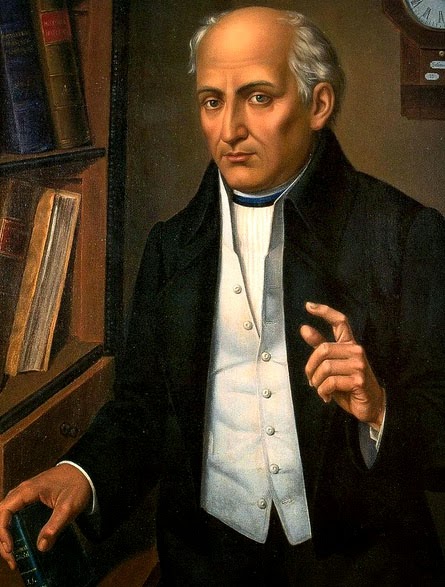 |
| Miguel Hidalgo y Costilla |
Lionized as the Father of Mexican Independence and champion of the downtrodden and oppressed, in 1810 the renegade parish priest Miguel Hidalgo y Costilla launched a failed rebellion against the Spanish authorities that ended in his capture and execution.
Despite its failure, the rebellion inaugurated an 11-year-long struggle for independence and exposed the deep fault lines of race and class that divided New Spain in the waning days of the colonial period.
Akin to the Haitian Revolution in terms of the horror it struck into the hearts of the privileged and propertied, the Hidalgo rebellion made glaringly obvious to Mexico’s elite the potential dangers of sparking social revolution from below in the fight for political independence.
  |
Thus, when independence did come in 1821, it came as a fundamentally conservative transfer of power that preserved the former colony’s rigid race and class hierarchies.
The son of a hacienda manager, Hidalgo studied at the Jesuit college in San Nicolás in Valladolid and the Royal and Pontifical University in Mexico City, earning his bachelor’s degree in 1774.
Steeped in the classics, he also delved into Enlightenment thinkers and learned several Indian languages. After entering the priesthood, from 1778 to 1802 he taught and served as rector at his alma mater of San Nicolás, earning a reputation as something of a maverick and freethinker.
Assigned to the backwater village of Dolores in 1803 as punishment for various offenses, he proved as much concerned with his parishioners’ material wellbeing as their spiritual salvation, instructing them in a host of practical enterprises (such as apiculture, viticulture, silk growing, and tile manufacture).
The parish of Dolores lay in the Bajío, the “breadbasket” of the colony just north and west of Mexico City. Over the previous decades, the Bajío had seen the progressive impoverishment of its mostly mestizo and Hispanized Indian population, along with an accumulation of social grievances that would prove crucial in the events to follow.
After the crisis of authority sparked by the Napoleonic invasion of Iberia in 1807–08, plots and conspiracies against the Spanish colonial government multiplied. One such plot, set to be launched on December 8, 1810, counted Hidalgo among its participants.
Upon learning that the authorities had been informed of the scheme, Hidalgo leapt into action. At around 2:00 in the morning of September 16, 1810, the slumbering residents of Dolores were awakened by the ringing of the church bell.
Addressing the assembled crowd in words that will never be known with certainty, Hidalgo, in his famous Grito de Dolores (Cry of Dolores) urged his parishioners to defend their religion and rise up against the bad government of the hated gachupines (Spanish).
Grabbing their hoes and digging sticks, the inflamed crowd made its way to nearby San Miguel, gathering recruits as it went. Around noon the next day, in the village of Atotonilco, Hidalgo appropriated from the local church a banner of the dark-skinned Virgin of Guadalupe, the patron saint of Mexico, which henceforth would serve as his movement’s emblem and standard.
The rebellion snowballed with astonishing rapidity. Looting and pillaging Spanish residences and public buildings, armed with machetes, slings, and farming implements, the crowd had become an impassioned mob of thousands.
Around noon on September 28, the ragtag army reached the provincial capital of Guanajuato, where they had their first sustained encounter with the Spanish military. Overrunning the town by sheer force of numbers, the crowd slaughtered some 500 Spaniards, burning, pillaging, looting the granary, and wreaking widespread havoc.
Over the next month, the army continued on its rampage, taking the provincial capitals of Zacatecas, San Luis Potosí, and Valladolid before heading toward Mexico City, the heart of Spanish power in the Americas.
On October 30, 1810, at Monte de las Cruces on the outskirts of Mexico City, Hidalgo’s 80,000 to 100,000-strong army defeated a much smaller but formidable Spanish force sent to stop them. At this point, Hidalgo made what many consider his most momentous and enigmatic decision.
Instead of following the advice of his lieutenants and sentiments of the crowd and descending into the colony’s capital city, he opted to retreat. Scholars continue to debate his reasons, though most consider that he found intolerable the prospect of the mass slaughter that would surely follow.
From this point the movement rapidly lost momentum, as his makeshift army divided and desertions mounted. In March 1811 Hidalgo was captured far to the north in the deserts of Coahuila. Tried and found guilty of heresy and treason, he was executed at dawn on July 31, 1811, his head displayed on a pole atop the ashen walls of the Guanajuato granary.
Mexicans celebrate national independence on September 15–16, in commemoration of Hidalgo’s Grito de Dolores, even though actual independence did not come until 11 years after the revered priest’s fateful cry.
More recent scholarship has focused on the social bases of Hidalgo’s rebellion and the confluence of social and cultural dynamics that created the most massive popular uprising in New Spain’s history.